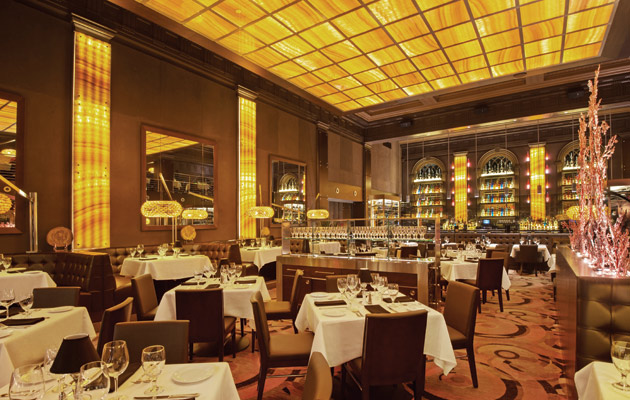"We move a lot of air through the cigar bar; all the air is changed over every six minutes. So it is not a big blue cloud all the time," quips Alexandra Renzetti, director of marketing at Leaf Cigar Bar and Famous Smoke Shop in Easton, Pa. Maybe you don't run a cigar bar, or even allow smoking in your restaurant, but rest assured you have offensive odors to remove from your business. No matter the concept, no matter how wow the décor or how au courant the design, if the air quality isn't up to snuff, customers won't sit still long enough to notice. They likely won't return, and they might even send you their dry cleaning tab.
"Customer satisfaction is linked to the restaurant environment as much as it is to the quality of the food," says Brian Chandler, PE, a principal, engineering lead and operations director for ID Studio 4, an integrated architecture and engineering firm based in Irving, Texas. "Air management in a restaurant is critical to control temperature, humidity, stuffiness and odors."
"Air management is all about the guests' experience. If it's too hot, they won't want to sit and eat, no matter how good the food is," adds Bill O'Keefe, executive director of development for DineEquity, the Glendale, Calif.-based company that operates and franchises more than 2,000 Applebee's and 1,550 IHOP restaurants. "You want guests to be comfortable, and at the same time you want the restaurant to be functioning properly."
Balancing Act
When it comes to managing air quality, restaurants pose some unique challenges.
"Restaurants present novel conditions not found in most building types, in that you are putting makeup air into the building and sucking it right back out with a huge fan. Then you have doors constantly opening and closing, which creates chaos," points out Brian Tepen, director of architecture and design for DineEquity.
"The restaurant air system has to be balanced," O'Keefe explains. In the back of the house, exhaust hoods over the cooking equipment constantly extract smoke and grease-laden vapor, creating 20 percent negative pressure. The restaurant needs to counterbalance that negative airflow with fresh and conditioned makeup air to the front of the house, he says.
"The reason the kitchen must maintain negative air pressure in relation to the dining room is so that all the odors from food prep and cooking don't seep out into the dining room," Tepen adds.
"In most instances, the net air balance for the entire restaurant should be positive (by either a minimum amount of 150 CFM, or 2 percent of the HVAC airflow, whichever is greater) to ensure infiltration of unconditioned outdoor air does not occur," Chandler says.
Running Hot and Cold
"Kitchens get incredibly hot from the equipment, so the chef and cooks need air conditioning, even in the winter. Yet guests in the dining room need heat," notes Don Waller, director of construction for Columbus, Ohio-based Cameron Mitchell Restaurants. "That's a challenge, producing heat in one area of the restaurant and AC in another. Balance is our biggest concern."
Keeping cooks cool in a hot environment is a key task of air-management systems. Air conditioning requirements depend upon kitchen square footage, the size of the cookline and number of staffers. "At Cameron Mitchell Restaurants, we want to create a comfortable environment for our associates to work in," says Waller, who adds that ample kitchen AC contributes to staff loyalty and lower employee turnover.
In the dining room, AC requirements will vary depending on the climate and season of the year. They also must adjust to the daily rhythms of a restaurant: full during mealtimes, empty between dayparts. That impacts temperatures and humidity. When operating at full tilt, the kitchen is hotter than during downtimes. When packed with customers, the dining room is warmer too, due to the body heat contributed by guests and staff, O'Keefe points out. Air conditioning must contend with those changing conditions. "That's why we install thermostats," he notes.
Excess humidity can also cause problems. "All restaurants operate with high humidity levels in both the dining and kitchen areas, which is introduced through people breathing, outdoor air ventilation and steam from cooking," explains Chandler. He recommends insulating ductwork to contend with this high humidity. "Much as condensate will form on the surface of a cold glass, a similar condition will occur with condensate forming on the surface of cold un-insulated ductwork, eventually dripping onto tables and guests," he warns.
If It Looks Like a Duct...
"From the design standpoint, you want the air-management system in the background, working efficiently, unobtrusively," Tepen says. "Ducts, vents, return grills in the dining room shouldn't compromise the design aesthetic." Guests shouldn't notice the mechanics.
"Sometimes, vents and grillwork can even be beautiful when integrated into millwork or ceiling designs," Waller suggests.
Not only should vents be visibly unobtrusive, but air currents should be undetectable. "Trying to push too much air through just a few air devices may result in uneven airflow where some guests feel heavy jets of wind, while others feel stagnant air," says Chandler. He recommends a large number of vents strategically located to evenly distribute air in the dining room.
In Leaf's restaurant and bar areas, perforated ductwork keeps the airflow diffused rather than just dumped into the space. "With the perforated duct we can move air throughout the space at a lower pressure, thus keeping the guests less aware of the massive amount of air flowing through the space," Renzetti says.




